Governor Kim Reynolds’ office would have had a large shortfall for the fiscal year that ended June 30 without a transfer of federal funds from the Coronavirus Aid, Relief and Economic Security (CARES) Act, state financial reports show.
Documents Bleeding Heartland obtained through public records requests indicate that in mid-September, the state’s accounting system showed $448,448.86 was needed to balance the fiscal year 2020 appropriation for the governor’s office. Reynolds’ chief of staff Sara Craig Gongol invoiced the Iowa Department of Homeland Security for exactly that amount in CARES Act funds shortly before the books closed on fiscal year 2020.
That invoice and an accompanying document on “COVID-19 Personnel Costs” were revised to incorporate language from U.S. Treasury guidance on allowable Coronavirus Relief Fund expenditures.
For many years, during several administrations, Iowa governors have maintained a larger office than the general fund appropriation would otherwise allow by having separate state agencies support some employees’ salaries. But it has not been typical to use hundreds of thousands of federal dollars to balance the books. Without the CARES Act funding, Reynolds’ office would have been deeply in the red during the last fiscal year, even after four state agencies chipped in a total of $357,652 to cover part of four staffers’ compensation.
A BUDGET OUT OF BALANCE FROM THE START
Long before the novel coronavirus was identified, I’d puzzled over how the governor’s office would pay for an expanding staff. In April 2019, Republican lawmakers approved the governor’s request for an additional $200,000 in state funds, bringing the appropriation to $2,303,954 for FY2020. At the time, Craig Gongol told GOP budget subcommittee chairs that the extra funding would pay for new analysts on health and tax policy.
In the summer of 2019, the governor’s office hired not only advisers to work on health and tax policy, but also a public relations manager with many years of experience and a new economic development adviser. In addition, the Iowa Department of Human Services was supposedly going to stop paying most of the salary for Reynolds’ deputy chief of staff, after that department’s former director publicly questioned such payments.
Soon after I learned Reynolds had allocated CARES Act funds to cover much of the compensation for 21 employees in her office from March 15 to June 30, I asked the Iowa Department of Administrative Services (which handles payroll for state government) for copies of all FY2020 month-end budget to actual financial reports documenting revenues and expenditures for the governor’s office. Fourteen such reports are enclosed below as Appendix 1. I received the files in Excel format and changed nothing other than to save them as pdf files so they could be displayed on this website.
You can see that all along, the governor’s office planned to spend far more than the state appropriation of roughly $2.3 million. The first month-end report for the fiscal year, covering July 2019, projects spending a little more than $2.9 million, around $595,000 more than expected revenues. “Personal services” (staff salaries and benefits) comprise most of the anticipated costs, just under $2.6 million.
As mentioned above, it’s long been standard practice for other state agencies to support personnel costs in the Iowa governor’s office. But the new Reynolds hires took it to another level. Several months in a row, spending budgeted for staff salaries increased, as did the projected gap between expenditures and revenues. (I confirmed through a separate records request that no individual on Reynolds’ staff got a large raise during the 2020 fiscal year; you can download that spreadsheet here.)
By October 2019, the governor’s office was on track to spend $2,822,455 on “personal services” alone and $3,136,211 on total expenses during the fiscal year, which was $820,367 more than projected revenues. The month-end report for December projected more than $3.2 million in spending, exceeding the budget appropriation by $881,103.
Projected costs for salaries and other expenses fluctuated from month to month, but the pattern was consistent. At the end of February, just before COVID-19 prompted Reynolds to declare a public health disaster emergency, the governor’s office was projected to spend $3,188,497 during the fiscal year, including $2,858,473 for staff pay, resulting in a gap of $855,133 between revenues and expenditures.
After Bleeding Heartland first reported on the use of CARES Act funds to pay Reynolds’ staff, some Democratic legislators wondered what happened to the $2.3 million the legislature had allocated for the governor’s office in FY2020. These financial reports answer that question: all of that money was spent, and then some.
CLOSING THE GAP
The governor’s communications director Pat Garrett did not respond to emails asking when Reynolds decided to use CARES Act funds to pay her staff, and how the office had planned to make up the budget shortfall before anyone know federal COVID-19 relief funds would be available to states.
Beginning in March, month-end reports projected $522,849 in “staff payroll adjustments” to offset some of the salary costs, resulting in a smaller gap ($331,697) between revenues and expenditures. The reports don’t indicate whether those adjustments were expected to come solely from state sources, or might include some federal money.
Things began to take shape in June, when Craig Gongol signed salary-sharing agreements with three state agencies worth a combined $294,700. Each agency agreed to cover 100 percent of the salary and benefits for one Reynolds adviser from the summer of 2019 through March 13, 2020. Similar agreements I’d reviewed in the past ran through the end of the fiscal year. The unusual ending date was a clue that some coronavirus related funding stream would pick up the tab.
Even after receiving $294,700 from other agencies, the governor’s office was on track to be well over budget for the fiscal year. A report generated for July put the expected shortfall at $579,141.
The fiscal year-end report is worth a closer look (click here to enlarge).
In addition to the $294,700 coming from salary-sharing agreements, we now see $448,449 in “Iowa Coronavirus Relief Fund Support.” On the left side, there is also a credit of $63,952 to reimburse part of Paul Trombino III’s salary. Trombino is the governor’s chief operating officer, but the Department of Administrative Services has been paying 100 percent of his compensation since Reynolds named him interim director of that agency in early March.
Those three funding sources offset $807,101 in spending by the governor’s office, bringing the total expenditures listed on the year-end report down to $2,418,098. That’s only $84,734 more than revenues for the year.
We’ll get to how they covered the last part of the shortfall in a moment. First, a look behind the scenes at how the CARES Act funding made its way to the governor’s office.
“WE RECEIVED A SURPRISE TODAY”
Most state government units that had staff working on the pandemic response received payments directly from Iowa’s Coronavirus Relief Fund. In contrast, CARES Act funding for Reynolds’ staff went first to the Iowa Department of Homeland Security and Emergency Management, and then to the governor’s office as an “intra-state transfer.” The two-step meant that most published reports do not show any COVID-19 relief funds paid to the governor’s office. Rather, they show $448,449 in spending by Homeland Security on “COVID Staffing” or “State Government COVID Staffing.”
That arrangement came together late in the game, Homeland Security department emails show. Those records are enclosed below as Appendix 2.
Reynolds authorized $1 million from the Coronavirus Relief Fund to Homeland Security “for COVID-19 staffing” on September 2, a few days after I started asking the governor’s spokesperson about CARES Act spending on his and his colleagues’ salaries. The Department of Management executed the $1 million transfer on September 9, according to Linda Leto.
Bonnie Rieder, the Disaster Grants Bureau chief for Homeland Security, emailed Director Joyce Flinn and other senior department staff the following day (emphasis in original).
We received a surprise today. DOM transferred the $1M for COVID-19 staffing into our FY20 account. The full amount will most likely carry forward to FY21 as we are almost done with FY20 corrections. We have until 2:30 PM on September 15 to process FY20 corrections. I have not received anything else on the $1M at this time.
Homeland Security communications staffer Lucinda Parker confirmed to Bleeding Heartland that as of September 10, leaders at Homeland Security were not aware of plans to utilize a significant portion of that $1 million to cover personnel costs in the governor’s office from mid-March through June.
They were still in the dark on September 11, the day the Department of Management sent me this list of dollar amounts for each of the governor’s staffers who had salaries and benefits paid from the Cornonavirus Relief Fund in FY2020.
“CAN YOU ADD THE FOLLOWING HIGHLIGHTED INFORMATION”
Rieder learned about plans for the “COVID staffing” funds on the morning of September 14, when David Fardal, a fiscal policy analyst for the Department of Management, contacted her to ask about the proper format for an invoice on behalf of the governor’s office. He soon asked her to review a sample invoice seeking $448,448.86 “For Governor’s Office employee salary/benefits for the time period March 15, 2020 through June 30, 2020 in support of Coronavirus relief efforts in Iowa.”
Rieder asked Fardal to “add the following highlighted information in the letter,” which she drew from the U.S. Treasury’s guidance:
1. are necessary expenditures incurred due to the public health emergency with respect to the Coronavirus Disease 2019 (COVID–19);
2. were not accounted for in the budget most recently approved as of March 27, 2020 […]
Fardal quickly sent back a revised version, the body of which was identical to the document the governor’s chief of staff later signed on official letterhead.
For Governor’s Office employee salary/benefits for the time period March 15, 2020 through June 30, 2020. These necessary expenditures were incurred in response to the public health emergency with respect to the Coronavirus Disease 2019 (COVID-19) relief efforts in Iowa. The expenses associated with COVID-19 support were not accounted for in the Fiscal Year 2020 budget approved by the Iowa Legislature in 2019.
“FY 2020 SHORTFALL” BECOMES “COVID-19 PERSONNEL COSTS”
As Department of Management staff scrambled to get Craig Gongol’s signature on the cover letter for the invoice on September 15, Fardal sent Rieder this table showing the salary and benefits for governor’s staff “involved in coronavirus relief efforts” and “the percentage used to arrive at the amount of support needed.” (click to enlarge)
The orange shaded line near the top indicates that the governor’s office “FY 2020 Shortfall Per I/3 Finance” is $448,448.86. That amount “is the difference between actual revenue and actual expenditures,” Leto explained via email. I/3 Finance is the state’s accounting and payroll system.
The governor’s office had previously sent the Department of Management a list of 21 employees involved in the COVID-19 response; I described their jobs here. Staff determined the salary and benefits for each employee from March 15 through June 30. The group’s total was $716,524; available funds would cover only about 37.4 percent of that amount.
Consequently, the three columns on the right of Fardal’s table showed the “Percentage Needed to Balance Appropriation,” the “Salary/Benefit Reduction to Balance Appropriation,” and “Revised Salary/Benefits to Balance Appropriation.” Using CARES Act funds for about 62.6 percent of each staffer’s compensation during the period would produce the magic number of $448,448.86.
Fardal asked Rieder to “review this information and let me know if it is acceptable documentation for CARES Act compliance.”
Rieder wrote back, “The spreadsheet reflects the amounts to balance but doesn’t indicate that it is COVID-19 related. I updated 4 headers for your consideration (highlighted).”
Near the top of the page, “FY 2020 Shortfall Per I/3 Finance” became “COVID-19 Personnel Costs.”
“Percentage Needed to Balance Appropriation” became “Percentage Budgeted.”
“Salary/Benefit Reduction to Balance Appropriation” became “Salary/Benefits Budgeted.”
“Revised Salary/Benefits to Balance Appropriation” became “Salary/Benefits Not Budgeted Related to COVID-19.”
Fardal agreed to the updated column headings and the signed invoice came back from the governor’s office the same afternoon, just in time to meet the state’s deadline for FY2020 adjustments. (Less than 24 hours after signing the invoice herself, Craig Gongol wrongly led journalists to believe the CARES Act money for staff salaries would be publicly disclosed after Reynolds signed the transfer documents.)
The table included with that final invoice was streamlined, missing two columns but keeping the “COVID-19 Personnel Costs” and “Salary/Benefits Not Budgeted Related to COVID-19” headings.
“NECESSARY EXPENDITURES” NOT “ACCOUNTED FOR IN THE BUDGET”?
The CARES Act allows governments to use the Coronavirus Relief Fund only for “necessary expenditures incurred due to the public health emergency” that “were not accounted for in the budget most recently approved as of March 27, 2020” and occurred between March 1 and December 30, 2020.
While everyone in the governor’s office must have spent a lot of time on pandemic-related matters, it’s far from clear that permanent staffers’ salaries and benefits meet this standard. Treasury’s guidance has stated,
Funds may not be used to fill shortfalls in government revenue to cover expenditures that would not otherwise qualify under the statute. Although a broad range of uses is allowed, revenue replacement is not a permissible use of Fund payments.
An updated version in September fleshed out the rules on using CARES Act funds for payroll and benefits of public employees (emphasis added).
This guidance reflects the intent behind the Fund, which was not to provide general fiscal assistance to state governments but rather to assist them with COVID-19-related necessary expenditures. With respect to personnel expenses, though the Fund was not intended to be used to cover government payroll expenses generally, the Fund was intended to provide assistance to address increased expenses, such as the expense of hiring new personnel as needed to assist with the government’s response to the public health emergency and to allow recipients facing budget pressures not to have to lay off or furlough employees who would be needed to assist with that purpose.
Reynolds didn’t hire new personnel in her office to help handle the pandemic workload. I’ve seen no evidence that layoffs or furloughs were ever considered for her permanent staff.
The CARES Act wasn’t designed to cover necessary expenditures incurred due to overspending your budget.
As for “not accounted for in the budget most recently approved,” the governor may point to the shortfall as proof that the $2.3 million line item in the FY2020 budget did not fully cover staff expenses. Her senior legal counsel Sam Langholz recently put forward a similar argument to justify spending $21 million in CARES Act funds on software the state had purchased in 2019. He noted that legislators had rejected the governor’s request to include that funding in the FY2020 budget.
But the appropriation for the governor’s office was obviously meant to include key staff positions. In addition, the month-end financial reports show that Reynolds’ office was anticipating more than $2.8 million in personnel costs from the earliest months of the fiscal year, long before COVID-19 had a name. In that sense, all the staff positions were budgeted for well in advance of the pandemic.
The Treasury Department has said that if a cost “is for a substantially different use from any expected use of funds,” it may qualify as not accounted for in the budget, even if there was a line item. The governor’s office has not specified what kind of work each staffer was doing from March through June. While some may have been engaged in “substantially different” work from their usual jobs, others appear to have played the same role as before (e.g. chief of staff, legal counsel, or communications director).
No one from the Department of Management or Homeland Security independently verified that the 21 employees in question were spending time on “substantially different” work. However, Rieder did convey “to the governor’s office the need to maintain their records in accordance with federal cost principles related to the CARES Act funding,” Homeland Security’s Parker told me.
At this writing, the remaining $551,551 in the “COVID Staffing” account has yet to be allocated. Homeland Security officials “are not the decision makers on how it will be spent,” and the governor’s office has not responded to inquiries.
FINAL NOTE: ONE MORE WAY TO BALANCE THE BOOKS
This last point is not related to federal funds, but raises questions state auditors may want to examine.
The year-end financial report shows the governor’s office was still $84,734 in the red after accounting for transfers from Homeland Security and other state agencies.
Scrolling down the page, the State-Federal Relations office, which functions as Iowa’s lobbying arm in Washington, DC, had revenues budgeted at $299,782, but expenses of only $215,047. Lo and behold, that operating surplus of $84,735 put total revenues for the governor’s office exactly one dollar over expenditures.
I asked the Department of Management: was the budget written to produce excess revenue in order to offset other expenses on Reynolds’ staff? Leto replied,
No, the budget was not written to produce excess revenue.
The Office of State-Federal Relations has been funded through assessments to state agencies throughout several governor administrations. The Office budget has been $299,782 since 2017 to support office operations which historically has included two full time staff. Currently one staff is employed in the Office of State-Federal Relations. The state has continued to maintain a consistent revenue stream to allow flexibility to fill the support position as needed.
Flexibility to fill the support position? Or to leave it open, so funds not spent in Washington can cover shortfalls in Des Moines?
Iowa law stipulates that the Office for State-Federal Relations is an “independent agency.” If the office has historically had two full-time staff, and state agencies were billed in FY2020 to support the cost of a two-person office, it seems dodgy to keep the office operating indefinitely with only one employee.
__________________
Appendix 1: Month-end budget reports for the Iowa governor’s office during fiscal year 2020. The Iowa Department of Administrative Services provided these reports as Excel spreadsheets. Without altering any entries, I saved them as pdf files in order to display here. Click on any hyperlink to enlarge or download any of the files.
Month-end report for July 2019
Month-end report for August 2019
Month-end report for September 2019
Month-end report for October 2019
Month-end report for November 2019
Month-end report for December 2019
Month-end report for January 2020
Month-end report for February 2020
Month-end report for March 2020
Month-end report for April 2020
Month-end report for June 2020
Report for “July hold open period”
Appendix 2: Iowa Department of Homeland Security records related to “COVID Staffing” payments
One page was missing from the records originally provided. Homeland Security produced this document upon request.
Top image: Governor Kim Reynolds discusses the COVID-19 pandemic at a May 19, 2020 news conference. Photo by Olivia Sun/Des Moines Register (pool).

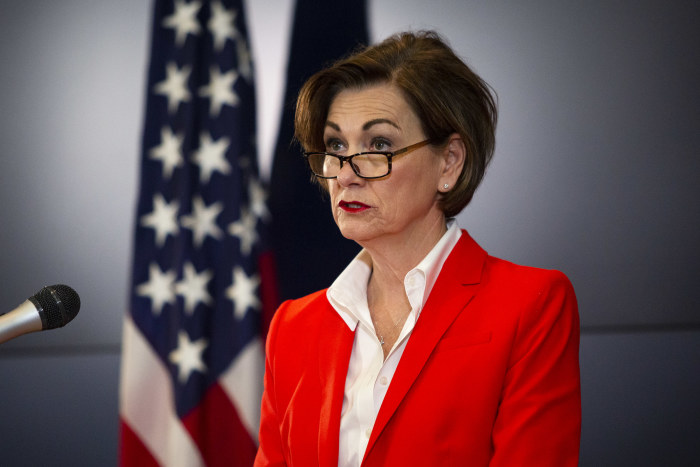


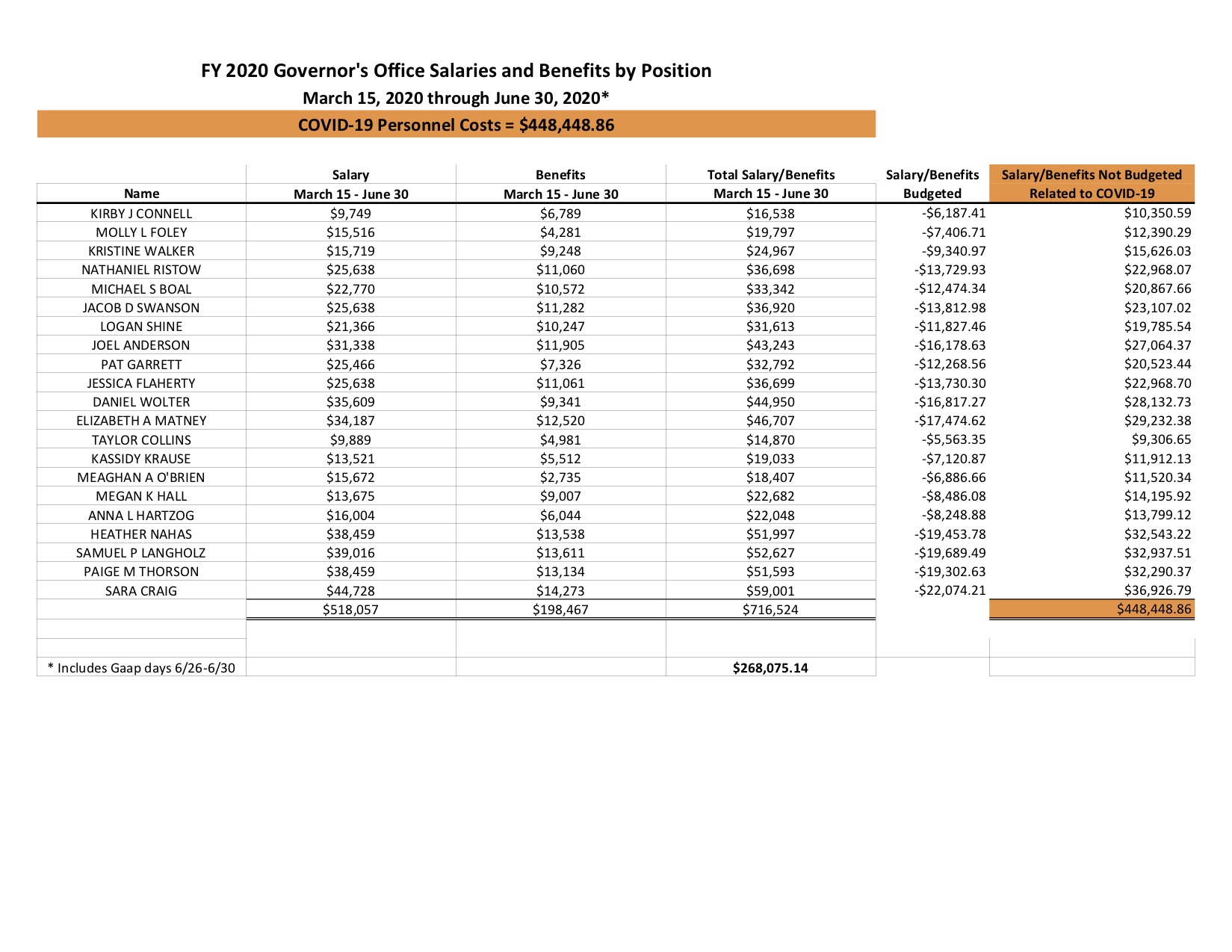
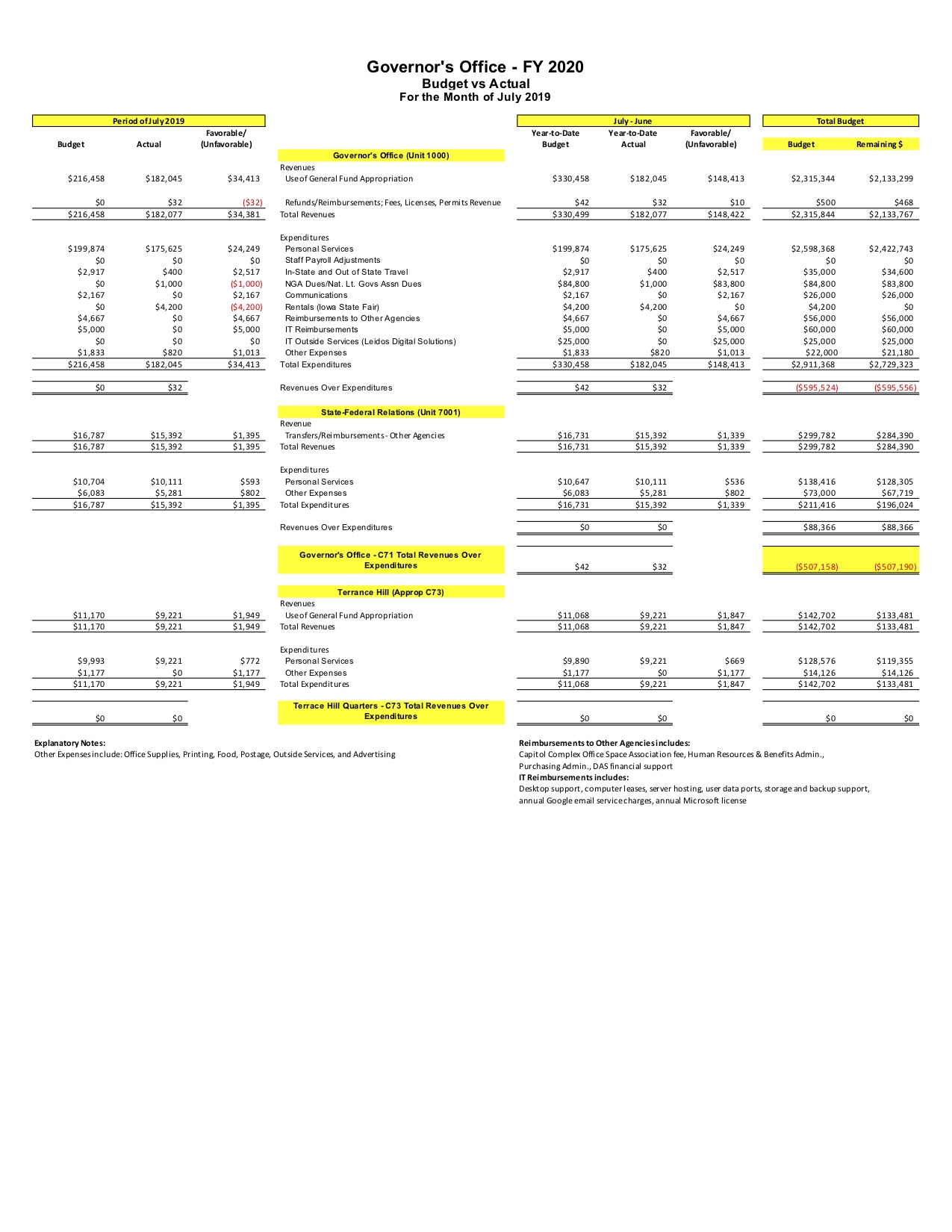
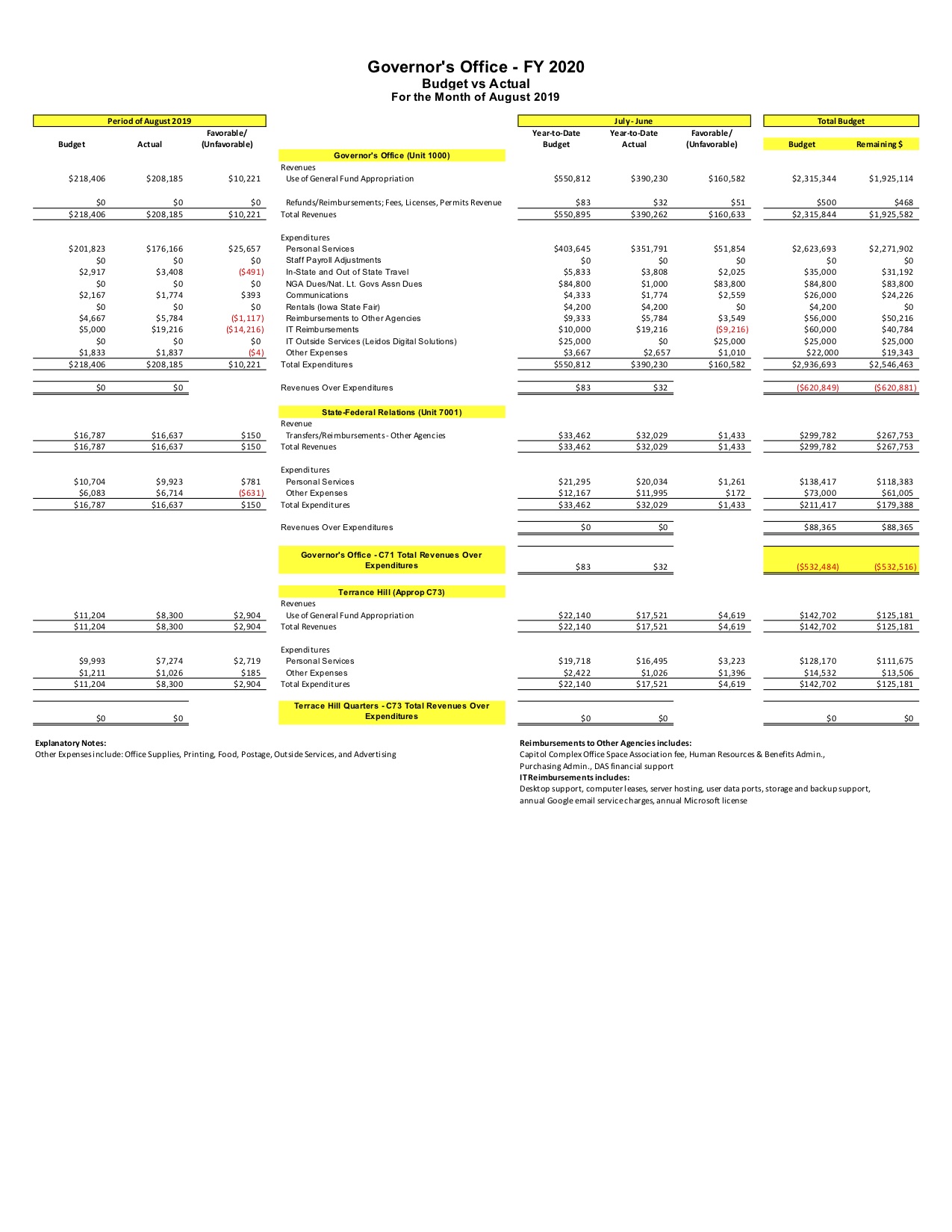
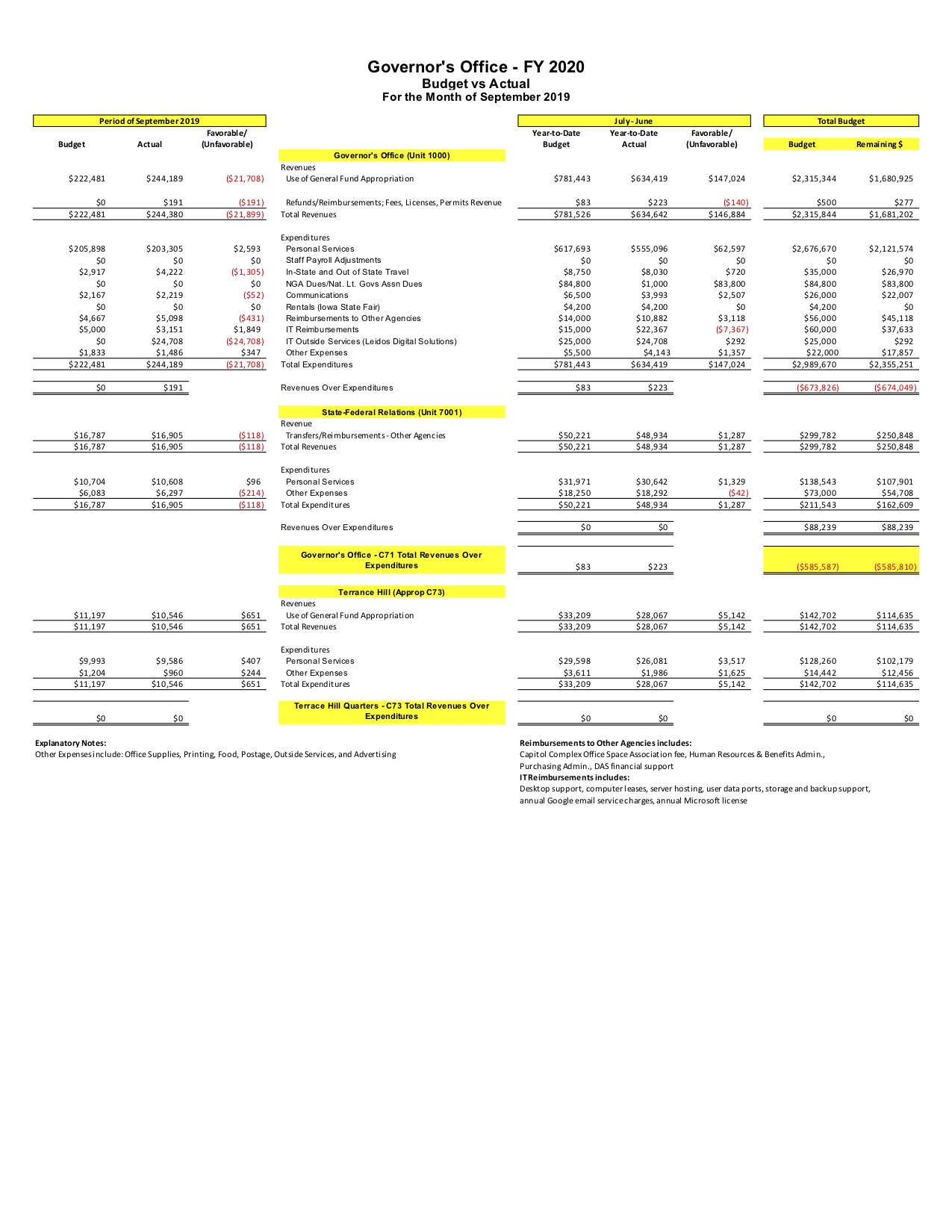
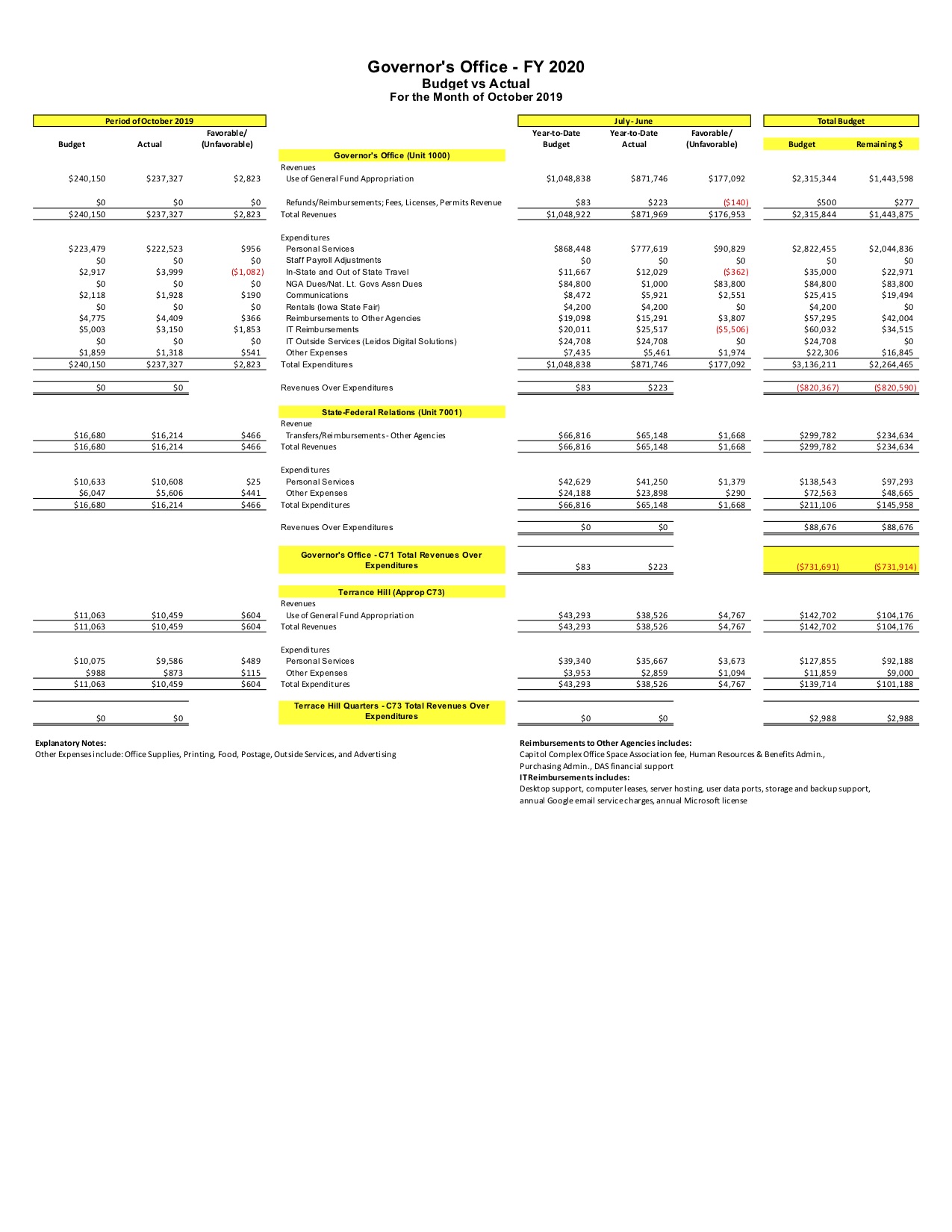
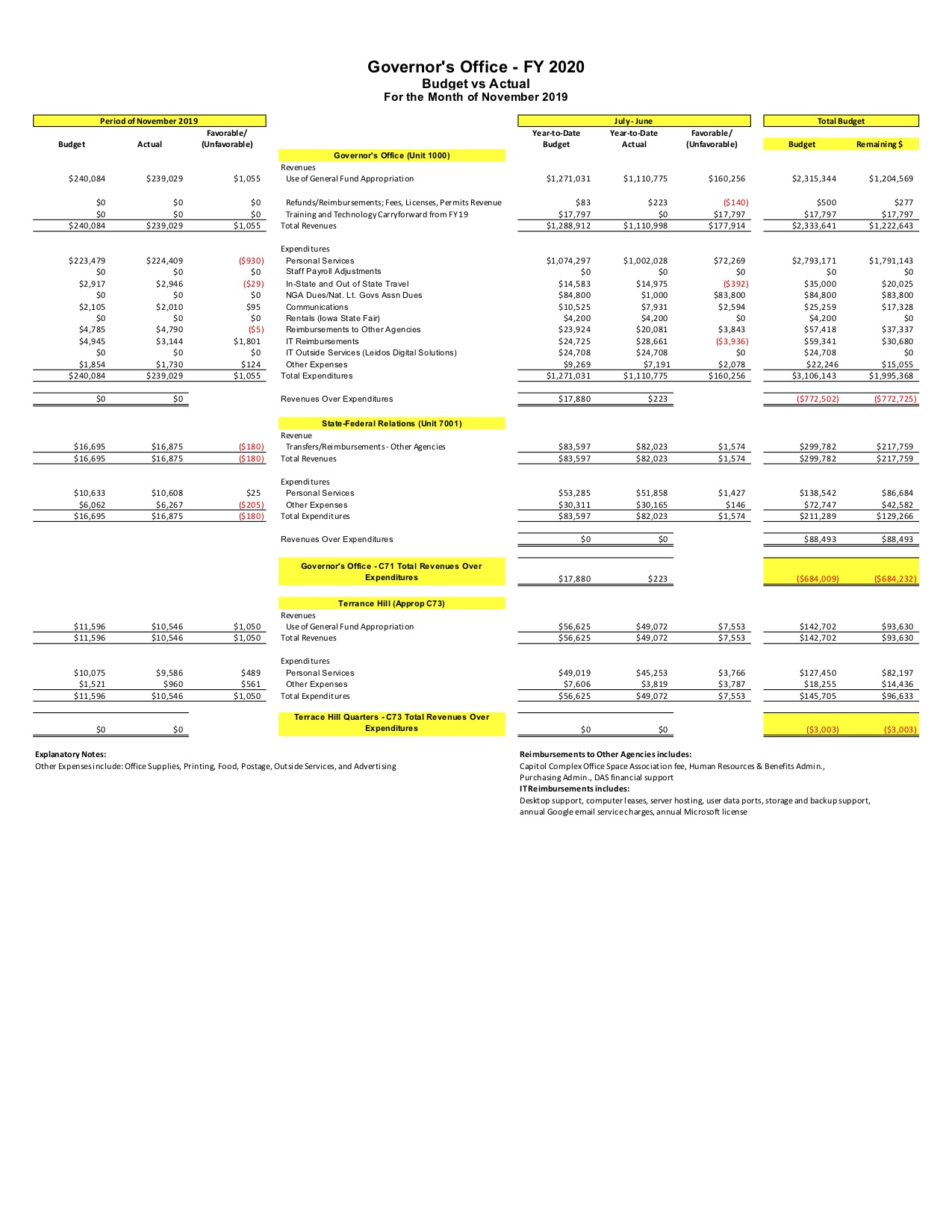
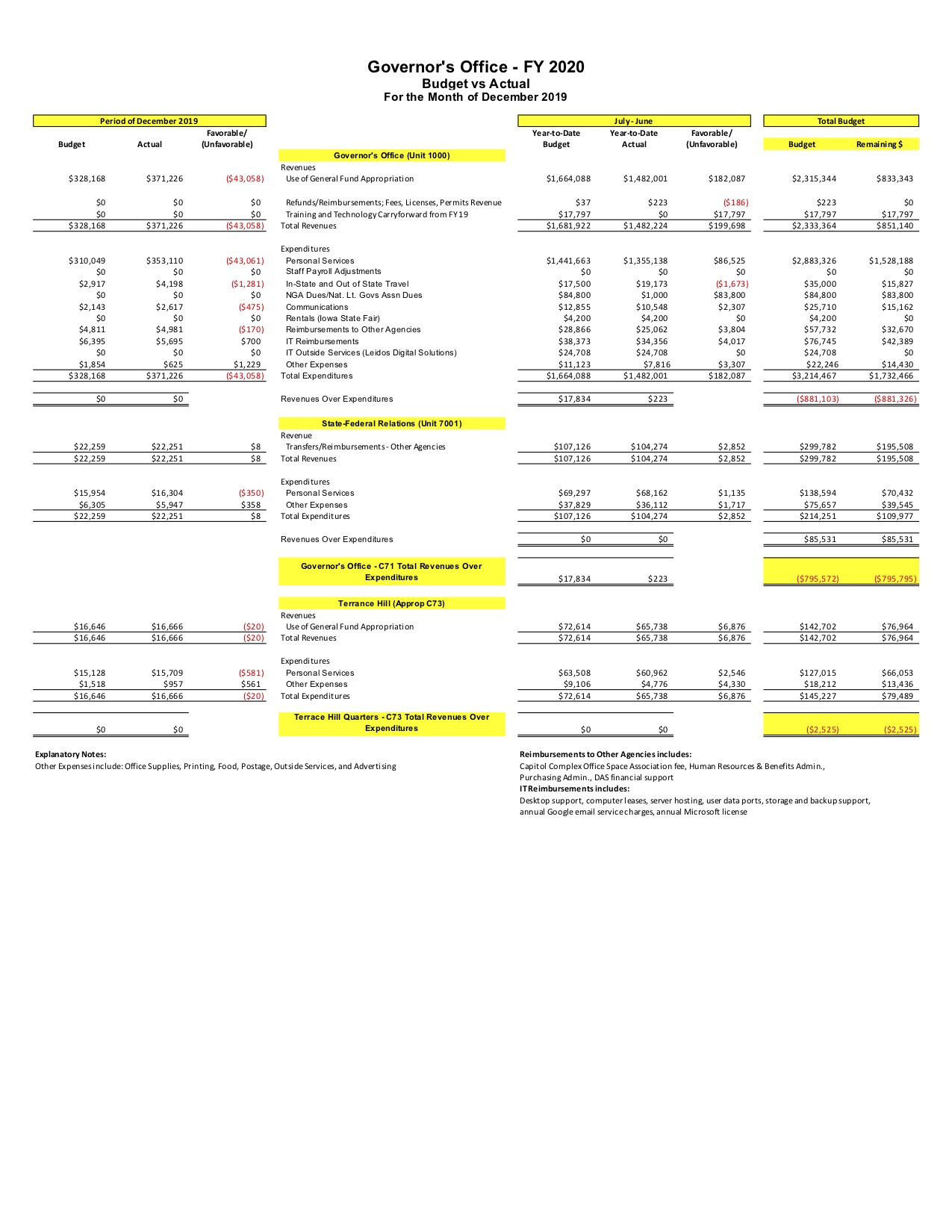
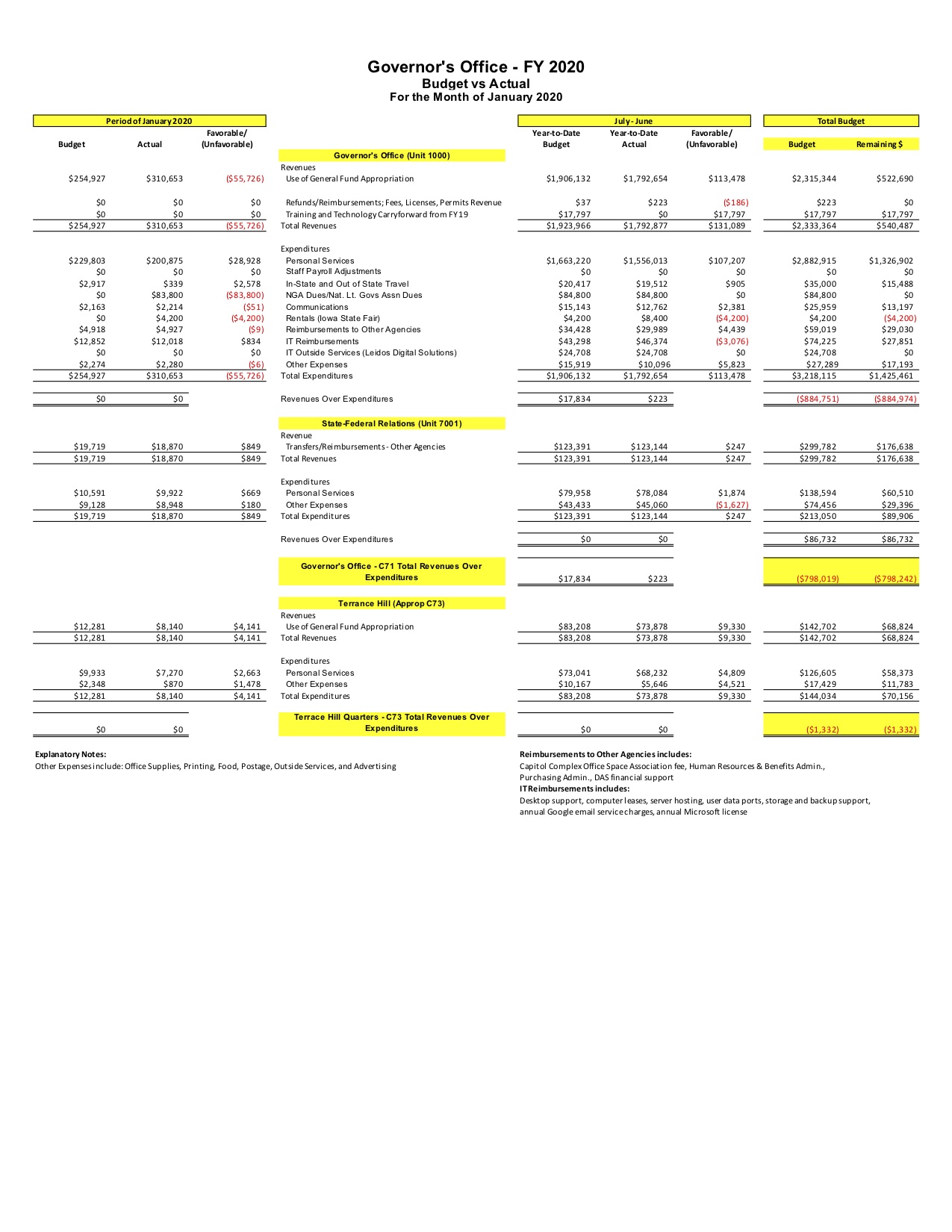
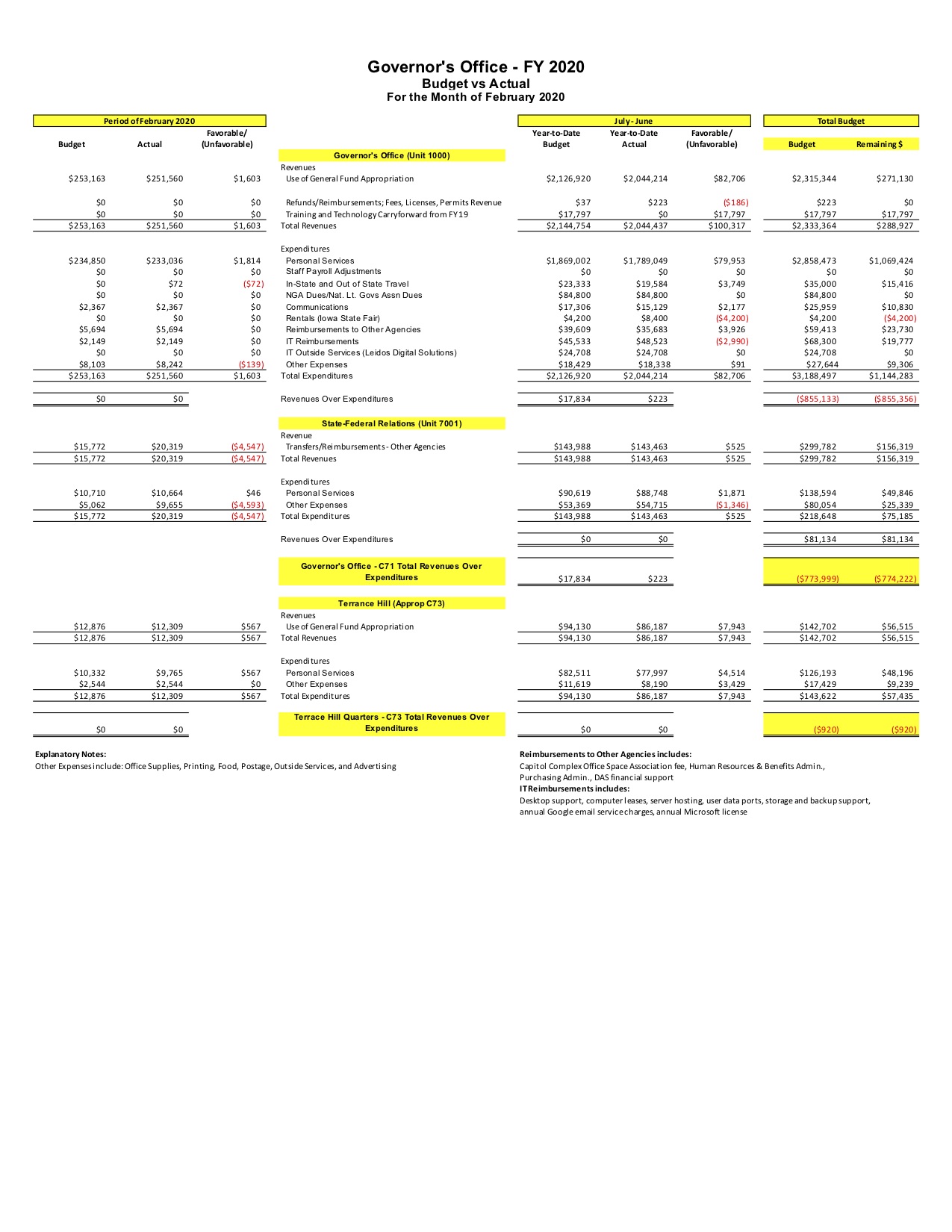
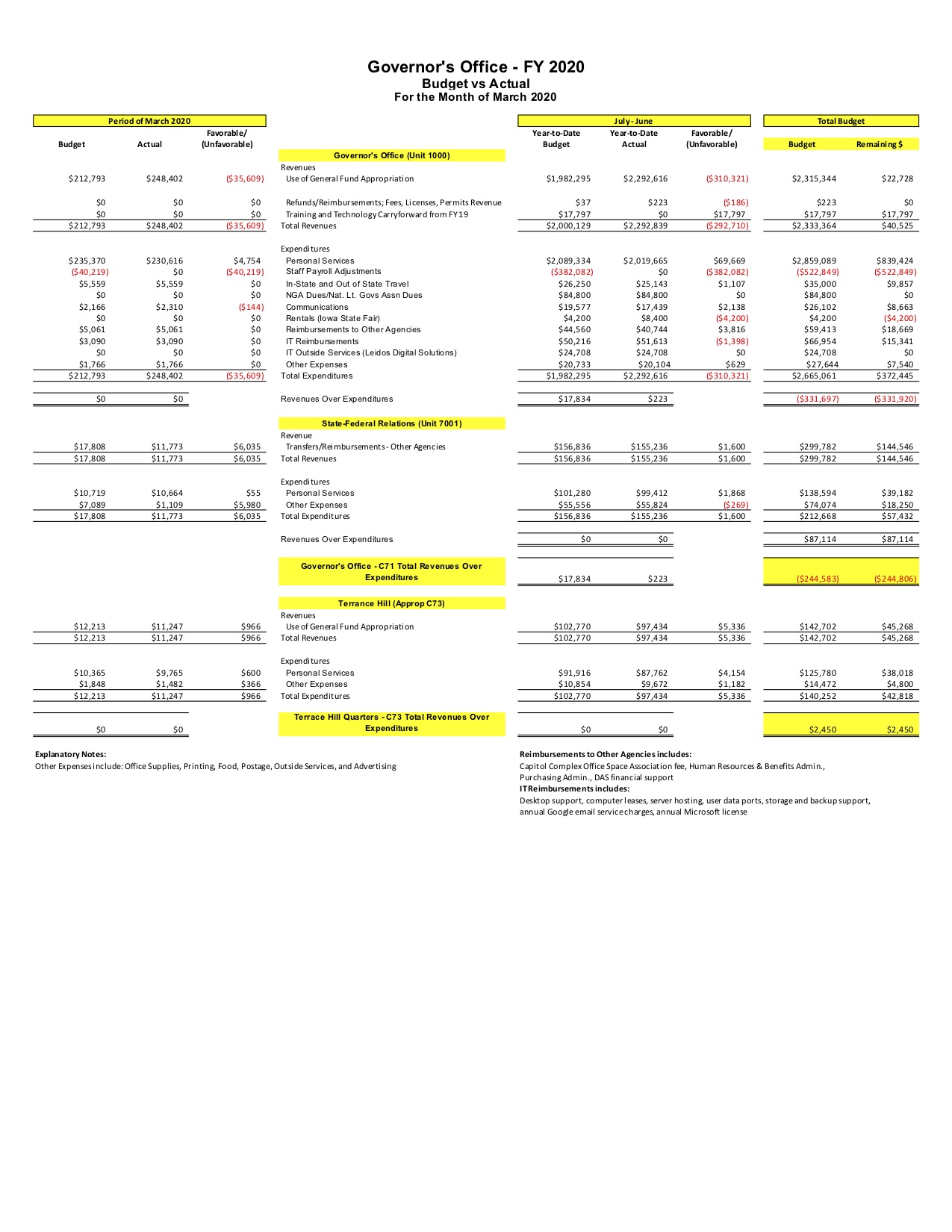
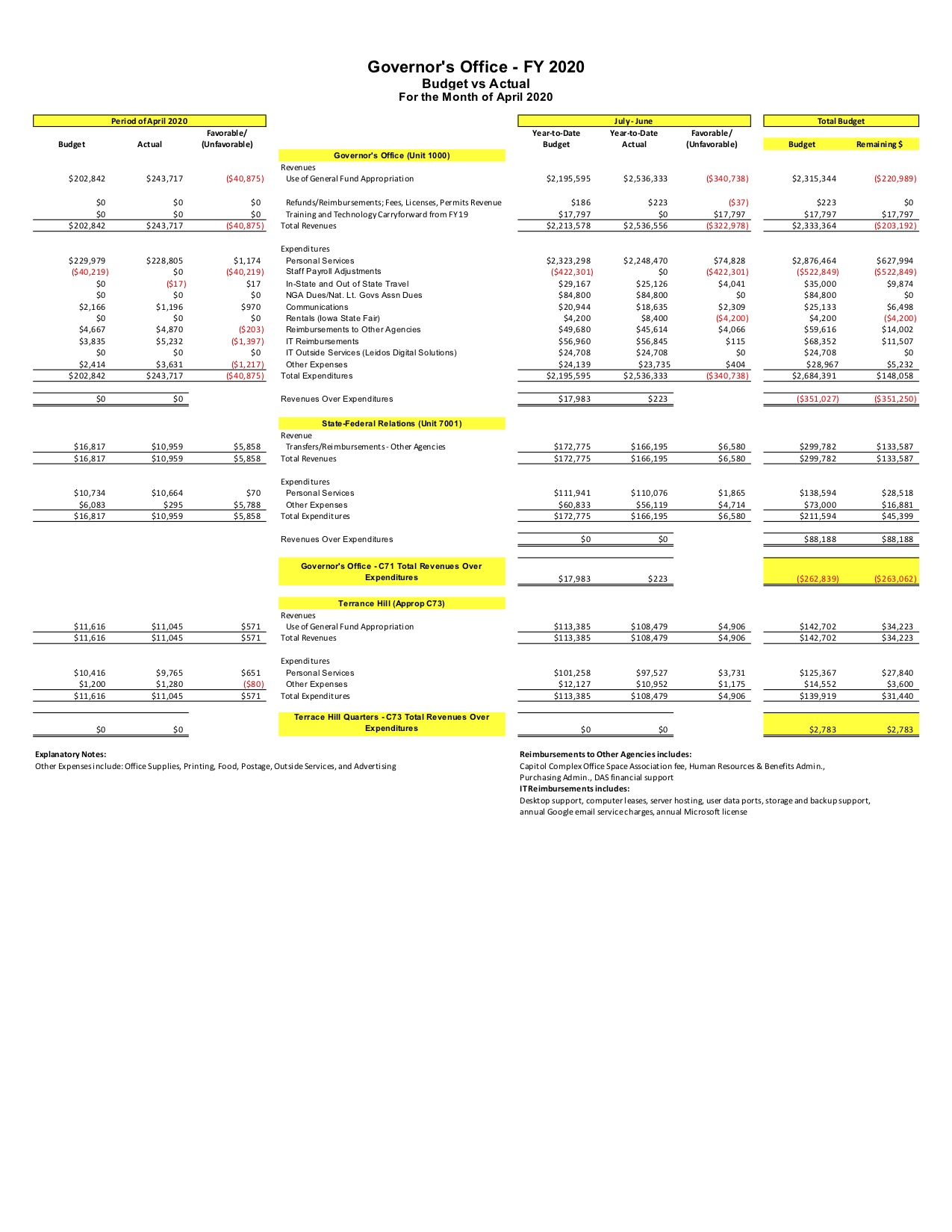
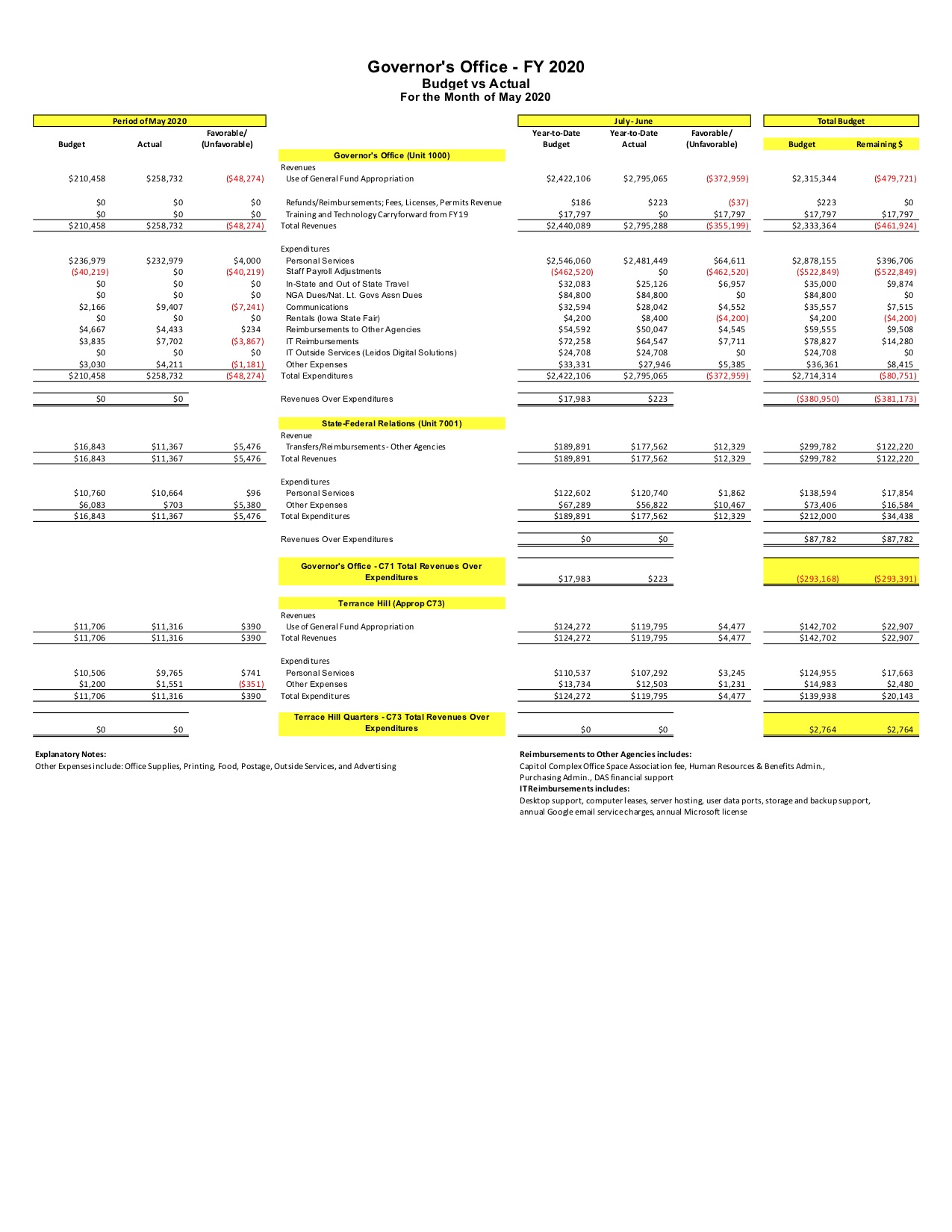
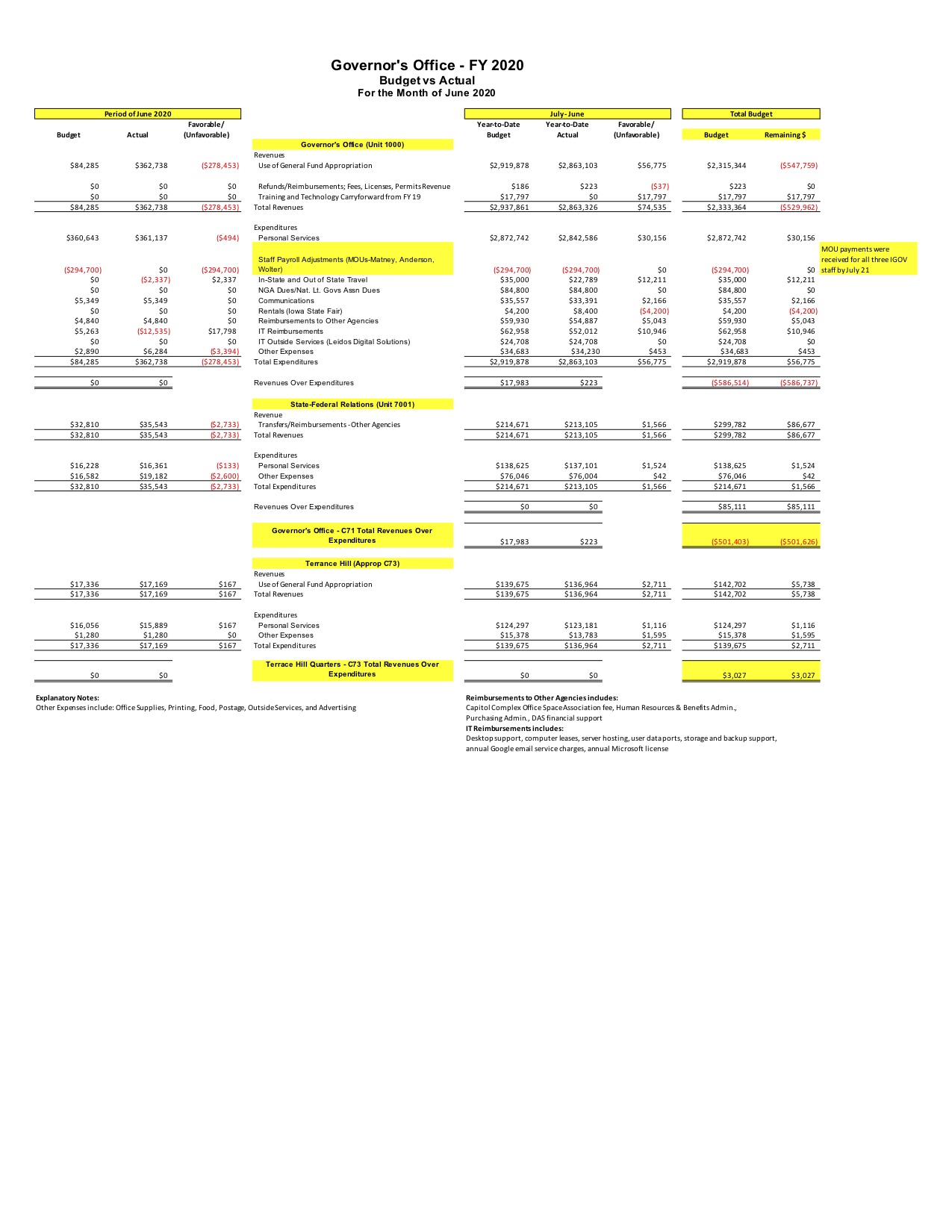
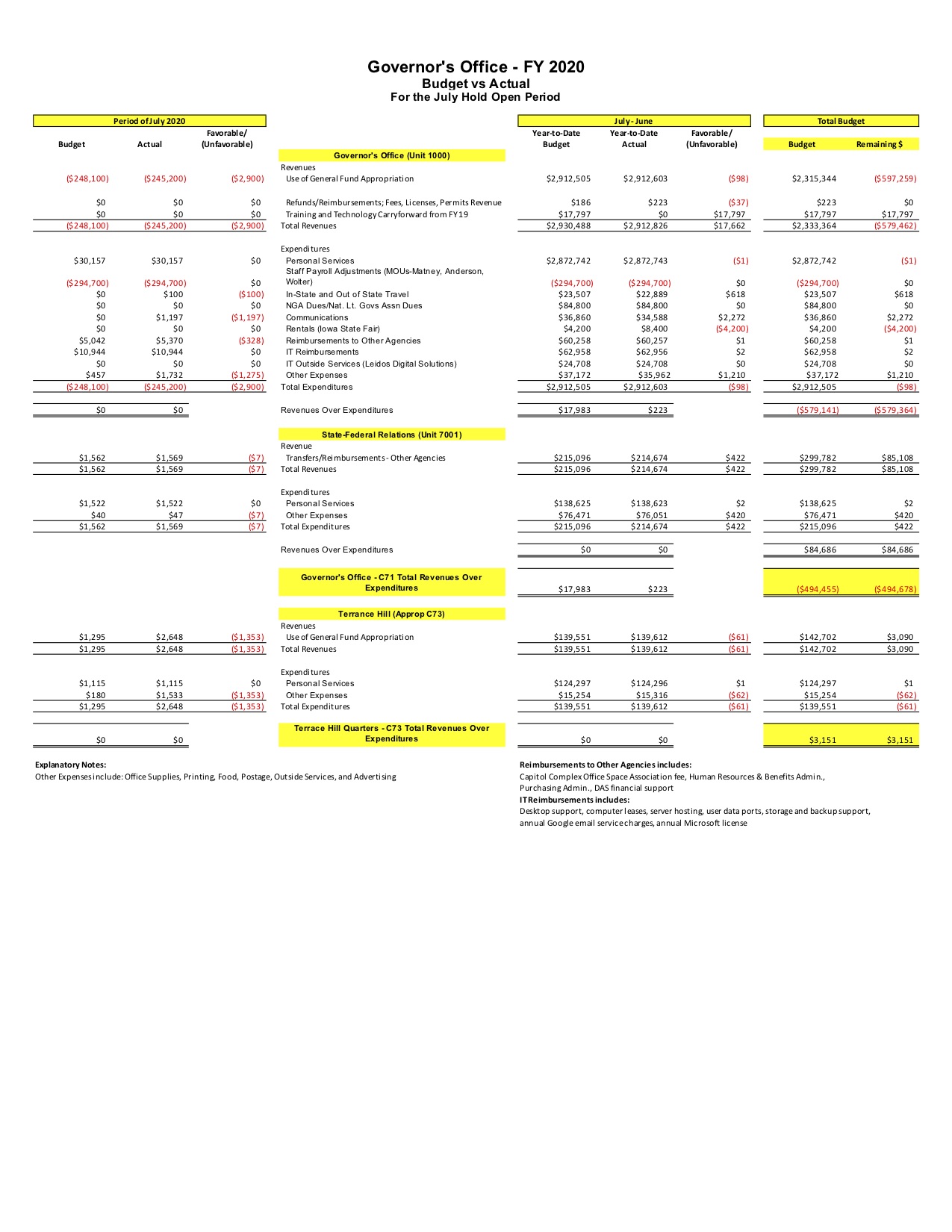

2 Comments
On one hand, this is a fine piece of journalism...
…but on the other hand, writing this is no way to get journalist credentials from the rulers of the present-day Statehouse. I’d suggest some kind of holiday puff piece on Kevin Reynolds:-).
PrairieFan Tue 8 Dec 4:23 PM
We'll see ...
You’ve done a lot of research for my representative, Mike Bergan, in his new leadership role on the House Budget and Regulation Appropriations subcommittee. We’ll see if he follows through with this or he carries more public relations water for the Governor’s office.
Thank you for this work.
Steve Peterson Sun 13 Dec 9:33 AM